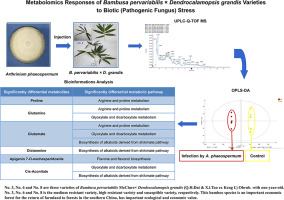当前位置:
X-MOL 学术
›
Phytochemistry
›
论文详情
Our official English website, www.x-mol.net, welcomes your feedback! (Note: you will need to create a separate account there.)
Metabolomics responses of Bambusa pervariabilis × Dendrocalamopsis grandis varieties to Biotic (pathogenic fungus) stress
Phytochemistry ( IF 3.2 ) Pub Date : 2019-11-01 , DOI: 10.1016/j.phytochem.2019.112087 Shujiang Li , Qianqian He , Qi Peng , Xinmei Fang , Tianhui Zhu , Tianmin Qiao , Shan Han
Phytochemistry ( IF 3.2 ) Pub Date : 2019-11-01 , DOI: 10.1016/j.phytochem.2019.112087 Shujiang Li , Qianqian He , Qi Peng , Xinmei Fang , Tianhui Zhu , Tianmin Qiao , Shan Han

|
Bambusa pervariabilis × Dendrocalamopsis grandis blight, caused by Arthrinium phaeospermum, is one of the most common and serious diseases in bamboo and occurs in the newly born twigs. Bamboo has suffered large dead areas, including more than 3000 hm2, which greatly threatens the process of returning farmlands to forests and the construction of ecological barriers. To identify differential metabolites and metabolic pathways associated with B. pervariabilis × D. grandis to A. phaeospermum, ultra-performance liquid chromatography (UPLC) and quadrupole-time of flight (Q-TOF) Mass Spectrometry (MS) combined with a data-dependent acquisition method was used to analyse the entire sample spectrum. In total, 13223 positive ion peaks and 10616 negative ion peaks were extracted. OPLS-DA and several other analyses were performed using the original data. The OPLS-DA models showed good quality and had strong predictive power, indicating clear trends in the analyses of the treatment and control groups. Clustering and KEGG pathway analyses were used to screen the differential metabolites in the treatment and control groups from the three B. pervariabilis × D. grandis varieties and reflected their metabolic responses induced by A. phaeospermum infection. The results showed that the three B. pervariabilis × D. grandis varieties mode showed significant changes in the following six resistance-related metabolites after A. phaeospermum invasion in positive and negative ion modes: proline, glutamine, dictamnine, apigenin 7-O-neohesperidoside, glutamate, and cis-Aconitate. The following four main metabolic pathways are involved: Arginine and proline metabolism, Glyoxylate and dicarboxylate metabolism, Biosynthesis of alkaloids derived from shikimate pathway, and Flavone and flavonol biosynthesis. This study lays a foundation for the later detection of differential metabolites and metabolic pathways for targeting, and provides a theoretical basis for disease-resistant breeding and the control of B. pervariabilis × D. grandis blight.
中文翻译:

Bambusa pervariabilis × Dendrocalamopsis grandis 品种对生物(病原真菌)胁迫的代谢组学反应
Bambusa pervariabilis × Dendrocalamopsis Grandis Blight 由 Arthrinium phaeospermum 引起,是竹子中最常见和最严重的病害之一,发生在新生的嫩枝上。竹子已遭受大面积枯死,其中3000多公顷,对退耕还林进程和生态屏障建设构成极大威胁。为了确定与 B. pervariabilis × D. grandis 到 A. phaeospermum 相关的差异代谢物和代谢途径,超高效液相色谱 (UPLC) 和四极杆飞行时间 (Q-TOF) 质谱 (MS) 结合数据 -依赖采集方法用于分析整个样品光谱。共提取13223个正离子峰和10616个负离子峰。OPLS-DA 和其他一些分析是使用原始数据进行的。OPLS-DA 模型质量好,预测能力强,表明治疗组和对照组的分析趋势明显。聚类和 KEGG 通路分析用于筛选处理组和对照组中来自三个 B. pervariabilis × D. grandis 品种的差异代谢物,并反映它们由 A. phaeospermum 感染诱导的代谢反应。结果表明,3种B. pervariabilis × D. grandis品种模式在A. phaeospermum侵袭后以正负离子模式表现出以下6种抗性相关代谢物的显着变化:脯氨酸、谷氨酰胺、白丹宁、芹菜素7-O-新橙皮苷、谷氨酸盐和顺乌头酸盐。涉及以下四种主要代谢途径:精氨酸和脯氨酸代谢,乙醛酸和二羧酸代谢,莽草酸途径生物碱的生物合成,以及黄酮和黄酮醇的生物合成。该研究为后期检测差异代谢物和代谢途径进行靶向奠定了基础,为抗病育种和防治B. pervariabilis × D. Grandis Blight提供了理论依据。
更新日期:2019-11-01
中文翻译:

Bambusa pervariabilis × Dendrocalamopsis grandis 品种对生物(病原真菌)胁迫的代谢组学反应
Bambusa pervariabilis × Dendrocalamopsis Grandis Blight 由 Arthrinium phaeospermum 引起,是竹子中最常见和最严重的病害之一,发生在新生的嫩枝上。竹子已遭受大面积枯死,其中3000多公顷,对退耕还林进程和生态屏障建设构成极大威胁。为了确定与 B. pervariabilis × D. grandis 到 A. phaeospermum 相关的差异代谢物和代谢途径,超高效液相色谱 (UPLC) 和四极杆飞行时间 (Q-TOF) 质谱 (MS) 结合数据 -依赖采集方法用于分析整个样品光谱。共提取13223个正离子峰和10616个负离子峰。OPLS-DA 和其他一些分析是使用原始数据进行的。OPLS-DA 模型质量好,预测能力强,表明治疗组和对照组的分析趋势明显。聚类和 KEGG 通路分析用于筛选处理组和对照组中来自三个 B. pervariabilis × D. grandis 品种的差异代谢物,并反映它们由 A. phaeospermum 感染诱导的代谢反应。结果表明,3种B. pervariabilis × D. grandis品种模式在A. phaeospermum侵袭后以正负离子模式表现出以下6种抗性相关代谢物的显着变化:脯氨酸、谷氨酰胺、白丹宁、芹菜素7-O-新橙皮苷、谷氨酸盐和顺乌头酸盐。涉及以下四种主要代谢途径:精氨酸和脯氨酸代谢,乙醛酸和二羧酸代谢,莽草酸途径生物碱的生物合成,以及黄酮和黄酮醇的生物合成。该研究为后期检测差异代谢物和代谢途径进行靶向奠定了基础,为抗病育种和防治B. pervariabilis × D. Grandis Blight提供了理论依据。






































 京公网安备 11010802027423号
京公网安备 11010802027423号